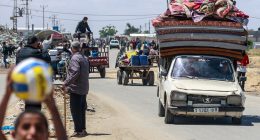
In director J.A. Bayona and cinematographer Pedro Luque‘s new film Society of the Snow, the filmmakers set out to create an ambitious adaptation of a book (of the same name) about the 1972 Uruguayan Andes flight disaster. The nonfiction book, which was written 40 years after the crash, documents the accounts of the 16 survivors — Bayona was attracted to the material because it was “less about the action and more about the reflection,” he told The Hollywood Reporter tech editor Carolyn Giardina during a special edition of THR Presents: Live from EnergaCameraimage.
The Netflix production, he adds, was treated in effect as a documentary; he began with extensive interviews with survivors and the families of victims. “I really wanted to find a new angle in the story because I knew the stories are very popular,” Bayona said. “To me, it was more about capturing the meaningful details.”
Filming took place at the actual crash site in the Andes, in a remote area of Spain, as well as on a soundstage that involved a 300 foot by 300 foot mountain set. Lensing the movie on a sea of white snow, Luque related that it was a “very empty canvas, but it becomes super expressive.” Added Bayona: “I really like this idea of a small figure in front of this white canvas, in front of this emptiness. Because to me, the characters go up there to discover the emptiness of life, and it’s on them to find the meaning. And in that sense, it became very, very symbolic.”
In the THR Presents interview, the pair discuss filming at the remote locations in freezing temperatures, the most challenging scenes to shoot and delicate work from departments including visual effects, sound and hair and makeup.
The director related that to prepare, the actors met with survivors and he held extensive rehearsals. Then, they filmed long takes in chronological order, giving the actors “the freedom to try things and to explore the story in different directions.”
His direction also involved staying with the actors so that the audience doesn’t know more than the characters do, for instance, when the survivors are huddled inside the plane as an avalanche occurs. For Bayona, it was about “being very close to the characters, knowing exactly what they knew, which was very, very little.”
Luque emphasized that filming was ultimately about following the actors and the emotion. “These are really fantastic group of actors that was really well prepared,” he says. “I was crying behind the monitors.”
This edition of THR Presents is sponsored by Netflix.
Read More: World News | Entertainment News | Celeb News
HollyWood








